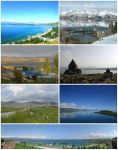Sevan (Armenian: Սեւան), is a town and urban municipal community, as well as one of the most popular resorts in Armenia, located in the Gegharkunik Province on the northwestern shores of Lake Sevan. The town is built at a height of more than 1,925 metres (6,316 feet) above sea level, 65 km (40 mi) northeast of the capital Yerevan, and 35 km (22 mi) north of the provincial centre Gavar.
Sevan is surrounded by the Sevan National Park, a natural protected area extending from the northeastern parts of the town to the southwest, while Lake Sevan forms the natural border of the city to the east.
As of the 2011 census, the population of the town was 19,229, and as per the 2016 official estimate, the population of Sevan is 19,200.
History
The territory of modern-day Sevan has been populated since the 3rd millennium BC. The cyclopean fortress of Metsep dating back to the 3rd millennium BC stands just north of the city. Another cyclopean fortress known as Mashtotsner is located in the Tsamakaberd neighborhood of Sevan.
After the establishment of the ancient Kingdom of Armenia, the territory of modern-day Sevan was included within the Mazaz and Varazhnunik cantons at the east of the historic Ayrarat province of Armenia Major.
The Sevan peninsula, located 3 kilometres (2 miles) east of present-day Sevan, is home to one of the most notable samples of medieval Armenian architecture, the Sevanavank Monastery of the 9th century. The monastery was mainly intended for monks from Echmiadzin who had sinned. Currently, the monastery consists of two churches: Surp Arakelots (Holy Apostles) and Surp Astvatsatsin (Holy Mother of God). The monastery is famous for its variety of the medieval Armenian Khachkars (cross-stones). Initially the monastery was built at the southern shore of a small island, that later turned into a peninsula during the 1st half of the 20th century, as a result of the artificial draining of Lake Sevan under Joseph Stalin's rule, causing the water level to fa
